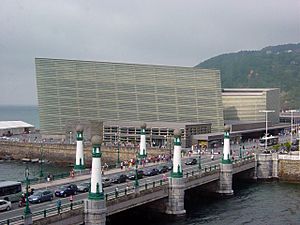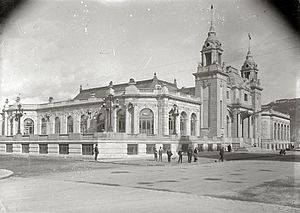Kursaal Congress Centre and Auditorium facts for kids
|
Kursaal Congress Centre
|
|

The Kursaal Congress Centre
|
|
| Location | Donostia-San Sebastián (Basque Country, Spain) |
|---|---|
| Type | Convention center |
| Opened | 1999 |
| Website | |
| Official website of the Kursaal: http://www.kursaal.org | |
The Kursaal Congress Centre and Auditorium is a famous building in Donostia-San Sebastián, Spain. It's a big place with many rooms for concerts, meetings, and exhibitions. A Spanish architect named Rafael Moneo designed it. The Kursaal opened in 1999.
This important building has several areas. It includes a large concert hall that can seat 1,800 people. The Kursaal is also home to the biggest film festival in Spain. This festival is called the San Sebastian International Film Festival. It has been happening every year since 1953.
Contents
History of the Kursaal Building
The Original Kursaal Spot: K Plot
Before the current Kursaal, there was an elegant palace built in 1921. It had a casino, a restaurant, a movie theater, and an 859-seat theater. This old palace was right in front of Gros beach. It was also next to the mouth of the Urumea river.
Part of the inside, including the main hall, was designed by Victor Eusa. Sadly, the entire building was torn down in 1973. This left an empty space, which people called the "K Plot." It was unusual for such a great spot to be empty for so long.
Choosing a New Design
When the old palace was taken down, a competition was held. The goal was to find a design for a new building. However, the winning design was never built. It was too complicated to create.
A new design idea came up in 1972. After some changes, building work started in 1975. But after the outer wall and foundations were done, the work stopped. The land then changed from private ownership to public ownership. A public group was formed to build a new center.
The Final Architect's Choice
The 1972 project was eventually set aside. In 1989, six famous architects were asked to propose designs. They were Mario Botta, Norman Foster, Arata Isozaki, Rafael Moneo, Juan Navarro Baldeweg, and Luis Peña Ganchegui.
Out of these six projects, Rafael Moneo's design was chosen. His idea was called "Two beached rocks." This design would become the Kursaal we see today.
Building the Kursaal: From Start to Finish
Rafael Moneo's design was drawn up between 1991 and 1994. Construction work began in 1996. The building was finally finished in 1999. There were some money problems during this time. The Basque Government, which paid 16% of the cost, did not want to give more money.
Once these problems were solved, the work finished in 1999. The Kursaal Congress Centre was designed by Rafael Moneo. It even won a big award in 2001. This award was the European Union Prize for Contemporary Architecture.
At first, some people in Donostia didn't like the new buildings. The city has many old, elegant buildings from the early 1900s. The Kursaal's simple, cube shape seemed to clash with this style. Also, a much more expensive museum, the Guggenheim Museum Bilbao, was being built in Bilbao at the same time. This took some attention away from the Kursaal.
However, after a while, most people got used to the Kursaal. They began to see how important it was for the city. It helps with the economy, brings tourists, and supports cultural events in Donostia. The Kursaal opened on August 23, 1999. The first event was a concert by the Euskadi Symphony Orchestra and Ainhoa Arteta.
The Kursaal Building's Design

The Kursaal looks like two large, clear blocks rising from a platform. People often call them "cubes." Each "cube" has an inner structure. This is surrounded by two layers of see-through glass panels. These panels are held up by a metal frame.
Between the two cubes, there is a large outdoor terrace. From here, you can see Zurriola Beach and the mouth of the Urumea river. This terrace is used for many events. It hosts many concerts during the Donostia Jazz Festival, also known as "Jazzaldia."
Here are some of the main spaces inside the Kursaal:
- Kursaal Auditorium
This is the biggest hall, located in the larger cube closest to the sea. It can hold 1,806 people. It is often used for major events and concerts. The first few rows of seats can be removed. This creates space for an orchestra during an opera.
- Chamber Hall
This hall is in the smaller cube and seats 600 people. It is used for smaller meetings or concerts.
- Multiple-use Rooms
These rooms are flexible spaces. They are used for various events with smaller groups of people.
- Exhibition Halls
These halls are designed for art galleries and other types of exhibitions.
- Kubo Hall
This is another exhibition hall. It is managed by the Kutxa savings bank.
The Kursaal building also has a restaurant owned by the famous chef Martín Berasategui. There are also several shops in the basement. A car park is available for visitors.
See also
 In Spanish: Palacio de Congresos y Auditorio Kursaal para niños
In Spanish: Palacio de Congresos y Auditorio Kursaal para niños



